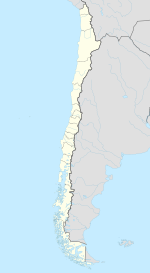Castro, Chile
| Castro | |||||
|---|---|---|---|---|---|
| City and Commune | |||||
|
|||||
| Coordinates (city): 42°28′S 73°48′W / 42.467°S 73.800°WCoordinates: 42°28′S 73°48′W / 42.467°S 73.800°W | |||||
| Country | Chile | ||||
| Region | Los Lagos | ||||
| Province | Chiloé | ||||
| Founded as | Santiago de Castro | ||||
| Founded | 12 February 1567 | ||||
| Government | |||||
| • Type | Municipality | ||||
| • Alcalde | Nelson Águila Serpa (DC) | ||||
| Area | |||||
| • Total | 427.5 km2 (165.1 sq mi) | ||||
| Elevation | 130 m (430 ft) | ||||
| Population (2012 Census) | |||||
| • Total | 41,667 | ||||
| • Density | 97/km2 (250/sq mi) | ||||
| • Urban | 29,148 | ||||
| • Rural | 10,218 | ||||
| Demonym(s) | Castreño / a | ||||
| Sex | |||||
| • Men | 19,325 | ||||
| • Women | 20,041 | ||||
| Time zone | CLT (UTC−4) | ||||
| • Summer (DST) | CLST (UTC−3) | ||||
| Area code(s) | 56 + 65 | ||||
| Climate | Cfb | ||||
| Website |
www |
||||
Castro is a city and commune in the Chilean island of Chiloé Island. Castro is the capital of the Chiloé Province in the Los Lagos Region. The city is located on Estero de Castro on the eastern coast of central Chiloé Island.
Castro is Chile's third oldest city in continued existence.Rodrigo de Quiroga as the temporary governor of Chile in 1567 launched a campaign led by his son in-law Captain Martín Ruiz de Gamboa to conquer Chiloé Island, establishing the city of Castro there, and pacifying its inhabitants, the Cuncos. From its founding on 12 February 1576 until 1767 Castro was the administrative centre of Chiloé Island. In 1594 Castro had 8,000 inhabitants most of whom were farmers. Up to the mid of the 17th century the town was looted by Dutch pirates several times. In 1767, during the time of the Bourbon Reforms that sought to modernize the Spanish Empire, Chiloé was separated from the General Captaincy of Chile to which it had previously belonged and made a direct subject of the Viceroyalty of Peru. To ease the communications with Lima the capital of the archipelago was moved from Castro to Ancud in the same year. Even after the incorporation of Chiloé of into the Republic of Chile Ancud remained the capital of the archipelago. Castro was destroyed by an earthquake in 1837 and had only 1,243 inhabitants in 1907. After the inauguration of the railway line to Ancud in 1912 the town developed better. Many buildings, e.g. railway station, town hall and many of the wooden palafitos houses, were destroyed or damaged by the earthquake and the tsunami of 1960. In 1960, Castro had 7.000 inhabitants. Only in 1982 did Castro regain its role as capital in Chiloé Archipelago.
...
Wikipedia



